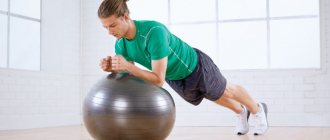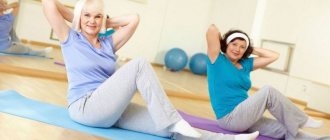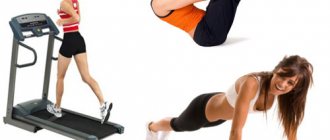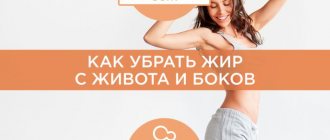To look at your bust in the mirror not with upset feelings, but with pleasure and pride, you need to take care of it at any age.
Contrast showers, cosmetics and special procedures, proper nutrition must certainly be combined with physical activity. But which ones? Don't rush to make a hundred searches on the Internet - just read this article to the end, in which we will look at the seven best chest exercises using dumbbells that are suitable for women and girls at any age.
Let's remember that we looked at 15 bust lift methods in the last article.
A little anatomy
The pectoral muscle group consists of two muscles, which in turn are divided into groups of fibers (long muscle cells). Their functions are to bring the hands to work and participate in the breathing process.
The largest of them is the pectoralis major muscle, which is located directly under the mammary gland and, with regular exercise, helps to increase its size and maintain its tone. It consists of three groups of fibers: clavicular-costal, sternocostal, abdominal.
The pectoralis minor muscle is located under the major muscle, originates from the ribs and is also divided into fibers - the 2nd, 3rd and 4th ribs.
It is worth noting that functionally the pectoral muscles are pusher muscles, so an effective set of exercises to work them should be aimed at pushing weights away from you and forward.
Abduction of arms to the sides while lying head down
This exercise with dumbbells on the floor or bench works the pectoral muscles. Workout technique: dumbbells weighing 3 kg. Perform 3-4 sets of 10-15 lifts.
- Sit on a horizontal, level support with your head down.
- Take the weights in your hands, palms facing inward.
- Raise your arms to the chest line, elbows bent and raised above the chest.
- From this position, lower and raise your arms to your chest.
- The tilt angle of the bench is no more than 30–40°.
Top 7 Proven Weight Exercises
So, we bring to your attention a selection of 7 proven movements with dumbbells for the bust area.
Bench press on a horizontal bench
In the dumbbell bench press, the load is focused on the lower part of the pectoralis major and deltoid muscles of the chest, the biceps and triceps, as well as the muscles of the shoulders, fingers and palms are involved.
- Lying on a bench, the legs rest on the floor on its sides, the lower back is in a natural deflection, the arms up to the elbow are in one line with the shoulder , from the elbows the forearms with dumbbells are raised up 90 degrees. The spread elbows should be slightly below chest level, the dumbbells should be higher. Deep breath.
- As you exhale, press the dumbbells to the top point with straight arms, hold for a moment and return your arms down.
To avoid execution errors:
- lift the dumbbells in parallel (they should not knock against each other at the top point or diverge);
- squeeze the load with your pectoral muscles, and not with your whole body or just your arms;
- do not take breaks during the approach;
- do not lift weights that you cannot handle;
- do not change the position of your legs and spine.
About 4 myths about the influence of the “Bench Press” on the female breast, 5 exercise options and detailed execution techniques, see here.
The peak of maximum stretch and tension of the pectoral muscles during the exercise occurs when the hands are at the bottom point at the beginning of the next lift.
Perform 3-4 sets of 10-12 push-ups with a 2-minute break between sets.
Incline Press (Positive Angle)
The pectoralis major (inner and upper parts), pectoralis minor, deltoids and coracoids, serratus anterior, trapezius scapulae and biceps are worked.
The technique of execution, breathing, the number of approaches and repetitions, the break between approaches - everything is the same as in a dumbbell press on a horizontal bench.
Peculiarity! The typical board inclination in gyms is 45 degrees. But with such an inclination, the load on the chest muscles weakens due to its redistribution to the shoulder muscles. In other words, the higher the angle of inclination, the less the chest muscles are involved in the work. To deeply work out the pectoral muscles, the angle of the board should be 20-30°.
Head down (negative angle)
The target of the exercise is the pectoral muscles, deltoids and coracoids, serratus ribs, trapezius shoulder blades and triceps.
- Lying on a bench inclined 30-40 degrees below the horizontal, legs placed behind special bolsters, lower back in a natural arch, arms with dumbbells raised up, hands grasping the dumbbells with your fingers away from you.
- Take a deep breath - lower the dumbbells to the lowest point on the sides of the chest, bending your elbows - they look to the sides. Exhale - on a new lift, at maximum load, the amplitude of the lift should be wide, at the top point the dumbbells should form the letter “L” and slightly touch each other.
Avoid prolonged cessation of breathing and take full, deep exhalations so as not to increase intra-abdominal and intrathoracic pressure. To prevent excess blood flow to the head, stand upright between sets.
Number of repetitions – 6-8, approaches – 3.
Hammer press
The load is focused on the abdominal fibers of the pectoralis major muscle, which are located under the mammary gland.
- Lying on a bench, press your arms bent at the elbows to the sides of your body, the fingers of your hands with dumbbells are directed towards each other (neutral or hammer grip) - starting position.
- As you exhale, straighten your arms up in front of you so that the dumbbells are at eye level, and as you inhale, straighten them back.
Repeat 7-9 times in 4 sets.
The exercise can be performed not only on a horizontal bench, but also set at different angles. The higher the angle, the less the load on the chest and the more on the shoulders.
Layout on a horizontal bench
An excellent exercise for tightening the pectoral muscles. The load is focused on the pectoralis major muscle; the muscles of the ribs and shoulders are involved in the work. This movement is great for removing underarm fat.
- Lying with your back on a bench (horizontal or elevated 30-40 degrees), arms with dumbbells slightly bent at the elbows and raised up, hands with dumbbells directed towards each other.
- As you inhale, slowly spread your arms to the sides - at the lowest point you should feel a stretch in the pectoral muscles, but not pain. Hold your hands for a few moments at the lowest point, and as you exhale, begin a new rise.
Perform 4 sets of 12 repetitions.
Incline bench fly
The pectoralis major, deltoid, biceps and triceps of the arms, and wrist flexors work.
The technique of execution and the number of executions are the same as in the fly on a horizontal bench.
A special feature of the exercise is the redistribution of the load depending on the angle of the bench. The higher it rises, the lower the emphasis of the load shifts along the pectoral muscle. The optimal angle is from 30 to 45 degrees.
Pullover (lying with one dumbbell)
The muscles of the entire upper body are loaded - the pectoralis major and latissimus dorsi, the shoulders, rib muscles and arms (especially the triceps) work. This exercise for the pectoral muscles helps expand the diaphragm and the chest as a whole. Performed on a horizontal (lengthwise or across) or inclined bench, lying on a fitball ball.
- Lie on your back, rest your feet on the floor, with two hands slightly bent at the elbows, grasp the bar of the dumbbell so that it passes between the two thumbs of your hands, the weight plate lies on your palms, and the bar and the bottom weight plate hang down. Raise your arms in front of you at head level – your eyes are looking at the dumbbell.
- As you inhale, slowly move your arms with the dumbbell back behind your head. The pelvis does not rise up with the arms, the angle of bend of the elbows does not increase, and muscle stretching is felt. At the bottom point there is a second pause, and as you exhale, the hands again go up from behind the head.
The approach includes 8-12 repetitions, they need to be done 3-4. The weight of a dumbbell can vary from 3-4 kg to 10 kg, depending on your level of training.
Exercises for chest muscles
The body must develop harmoniously. Otherwise it will look disproportionate. Therefore, you should not neglect basic exercises that involve all muscle groups, and not just the pectoral ones. The main goal should be the development of the whole body, and not a specific part.
Training for the pectoral muscles is often carried out in conjunction with exercises for training the back. If the emphasis during training needs to be on the chest, exercises for its development should be done first. This will allow you to achieve maximum dedication due to the fact that there is always more strength at the beginning of the workout.
Recommendations for performing the complex
So you have learned how to tighten your breasts using weights. In addition to dumbbells, body bars, barbells, and special cuffs can be used as weights. Auxiliary equipment will also help to train the pectoral muscle - balls (regular and fitball, rubber bands, etc.). The strength complex must necessarily include presses, raises and abductions, classic push-ups or lightweight push-ups from the wall and from the knees.
Its implementation will give maximum effect and will not cause discomfort to the body if you follow a few simple rules:
- Regularity and alternation of complex exercises. Beginners can start training twice a week - the body needs time to recover. Divide the exercises of the complex equally and distribute them over these two classes. When you get stronger, start doing 3 times, divide the complex into three, but add one approach to each exercise.
- Study of various zones. You shouldn’t focus only on chest exercises, because this is only part of a beautiful and strong body. Make your training program comprehensive - don't forget about your abs, arms and shoulders, back, legs and buttocks.
- Warm up and cool down. The effectiveness of your workout will be much higher, and the risk of injury will be lower, if you do not forget about the golden rule of any exercise - a 5-10-minute warm-up to warm up your muscles before training and a short stretching routine after it.
- Time for training. It should be convenient for you. But the evening is considered optimal - after the usual daytime load, the susceptibility of muscles to injury decreases.
- Comfortable clothes and shoes. Any strength training puts stress not only on muscles, but also on ligaments, bones, joints, and skin. Proper and comfortable clothing will help avoid discomfort. Also take care of a sports top-bra - it will provide support for your breasts and prevent its ligaments from stretching due to active vibrations.
Serious training of any part of the body requires not only aerobic, but also strength training. When choosing a type of weight, many people prefer dumbbells. It’s not surprising, because dumbbells have a number of advantages:
- Convenience and accessibility. They can be purchased, without serious financial costs, in any store or supermarket department that sells sports equipment. They do not require special storage conditions, and they take up minimal space.
- Long service life and easy to use. Once you buy them you can use them for the rest of your life.
- Multifunctionality. Dumbbell movements are included in many strength training routines. They are universal for working out any muscle groups, while exercise machines are usually for 2-3.
Top 5 effective exercises without dumbbells for the pectoral muscles at home
Exercise 1: push-ups. An action familiar from physical education lessons is a great way to keep your body toned. Hands shoulder-width apart firmly rest on the floor. Legs are straight. Do 3 sets of 15 repetitions daily. Half a minute of rest is required between sets.
Exercise 2: advanced push-up . Bringing the hands closer together is added to the standard method. Alternately, with each press, place your hand on the opposite one. The number of approaches is identical to simple push-ups.
Exercise 3. Position – standing, back straight. Stand on your toes, alternately throw your arms as high as possible. The principle is similar to when a person tries to get something from the top shelf of a closet. Requires 2 sets of 10 repetitions on each arm.
Exercise 4. You will need a chair without casters. Sit in it, stretch your legs forward and lean on the floor. Place your hands on the arms of the chair and lift your body. The top point is a fully straightened body. The exercise is performed in 2 sets of 10 times.
Exercise 5: Ball Squeeze. Position – standing, straight posture. Hold a gymnastic ball between your palms at chest level. Using springy movements, try to connect your palms, as if through the ball. The muscles of the arms, back and chest should be tense. Perform 3 sets of 10 presses.
Don’t miss the most popular article in the section: Glutamic acid - what it is, why and how it is used in sports and bodybuilding.
No to vain fears
Many ladies are afraid of weight training, horrified by photographs of hyper-muscular women from some bodybuilding magazine and afraid of becoming like them. Don't worry, this won't happen.
There are only a few of these girls, they have dedicated their whole lives to this sport, they work for many hours every day in gyms with heavy weights, take special dietary supplements, adhere to a strict regime, take part in prestigious competitions, and shape themselves under the guidance of experienced coaches. Their goal is high professional sports results. However, even in this case, you can remove excess muscles, if desired.
Your goal is completely different, and the loads are different. But by regularly exercising at home or in the gym, you will get an attractive bust, even posture, straight shoulders and a confident gait.
10 more tightening methods
Pay attention to other ways to combat the problem:
- Gymnastics. It has a great effect on the chest muscles, corrects posture and thereby visually enlarges the bust.
- Crema. They make the skin tightened and elastic, slow down its aging. They are an important part of comprehensive care.
- Masks. Allows you to actively saturate the skin with nutrients and moisturizers. Keeps breasts toned.
- Wraps . This procedure, carried out using various components, has a wide range of possibilities - from lifting to regeneration.
- Massage. Helps enhance the effect of other procedures, improving blood circulation and affecting biologically active points.
- Diet and special products. A balanced diet helps maintain youthful skin. The beauty of your bust starts with proper nutrition.
- Pull-up bra. An important part of the women's toilet! It has an aesthetic function, making the silhouette slimmer and lifting the chest.
- Special stickers. Fashionable items, indispensable when wearing open clothes.
- Mesothreads. This procedure helps to lift the problem area and give it a natural shape. Installation of mesothreads has some contraindications, so consult your doctor carefully.
- Rubbing in oil. Helps smooth the skin and increase its firmness and elasticity. It is also useful to use them to prevent stretch marks.
With the help of exercises, as well as the above methods, you can achieve significant results.
Advice from professionals: how to increase the effectiveness of your classes
- Motivation. You should start exercising with a positive attitude. The purpose and future result of the training must be clearly understood.
- Correct breathing. Following breathing techniques will help you lose weight and minimize feeling unwell during exercise.
- Water balance. Drinking 300 ml of water after training can restore balance and improve muscle tone.
- Proper nutrition. You can't go hungry while training. But it is also prohibited to train on a full stomach.
- Rest. Without proper rest, there will be no results from classes. The right balance of dumbbell chest exercises and rest is the key to effective training.










